Believe me when I say this Crispy Orange Tofu recipe is “soy” good! It’s filling and satisfying thanks to plant-based protein, plus it’s served with stir-fried veggies, a sweet orange sauce, and lo mein noodles. Read more to learn how to make this colorful, flavorful, and nourishing vegan stir fry.
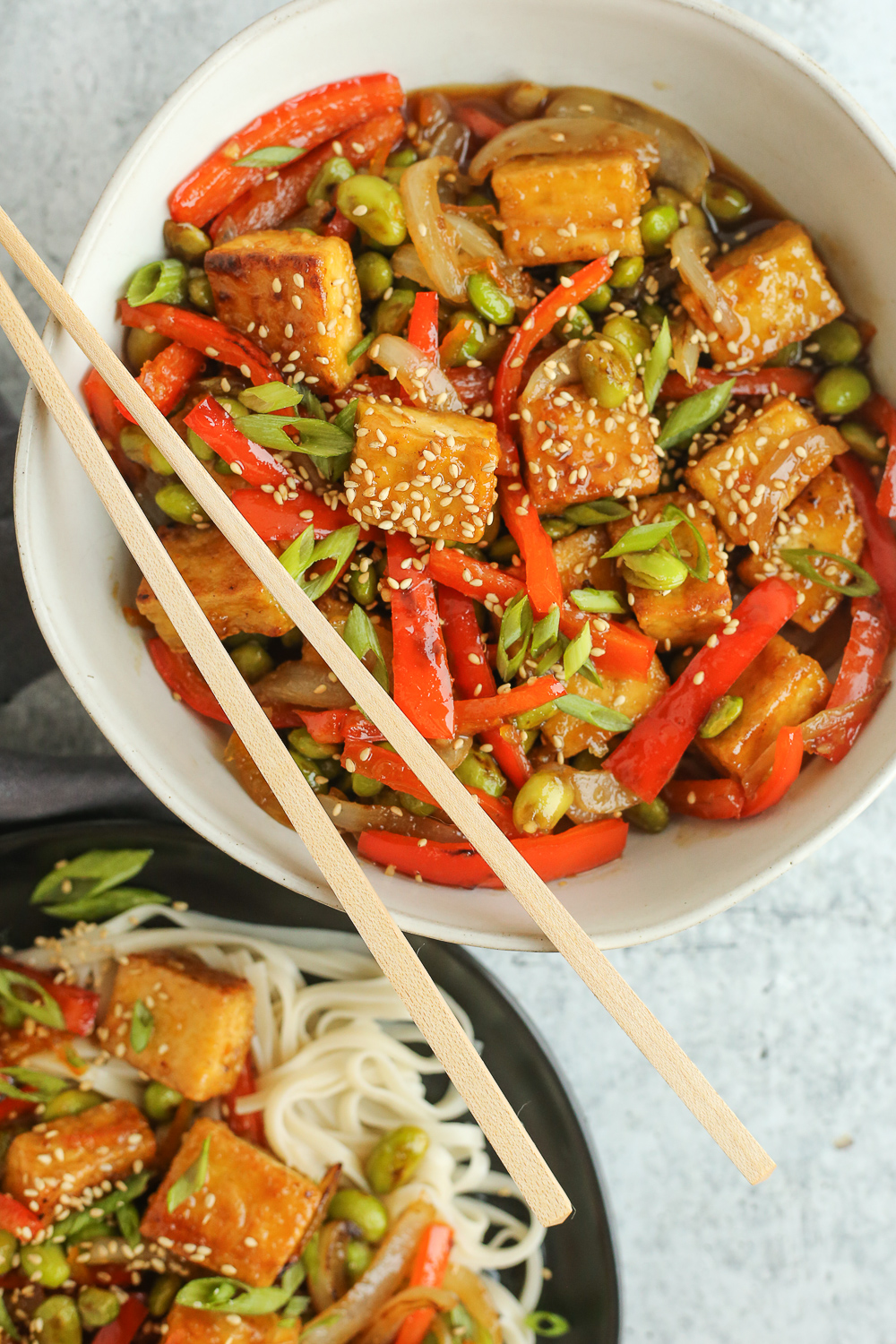
Disclosure: This post was sponsored by Soy Connection, the Soy Nutrition Institute, and the United Soybean Board when first published in August 2021. I was compensated for my time. It has since been updated to improve the overall quality of the information and/or images. I did not receive additional compensation to make these updates.
If you’re a fan of orange chicken, you know exactly what makes it taste so good: it’s that sticky orange sauce!
Although I don’t discriminate when it comes to protein sources, not everyone eats chicken. But nothing to fear, there’s no reason vegans and plant-based foodies can’t get in on the action. Thing of this Crispy Orange Tofu recipe as a version of vegan orange chicken.
If you’ve been following me for a while, you know stir fry recipes are a staple in my kitchen. We eat them at least once a week (sometimes more) and often enjoy leftovers. This easy orange tofu recipe is no different!
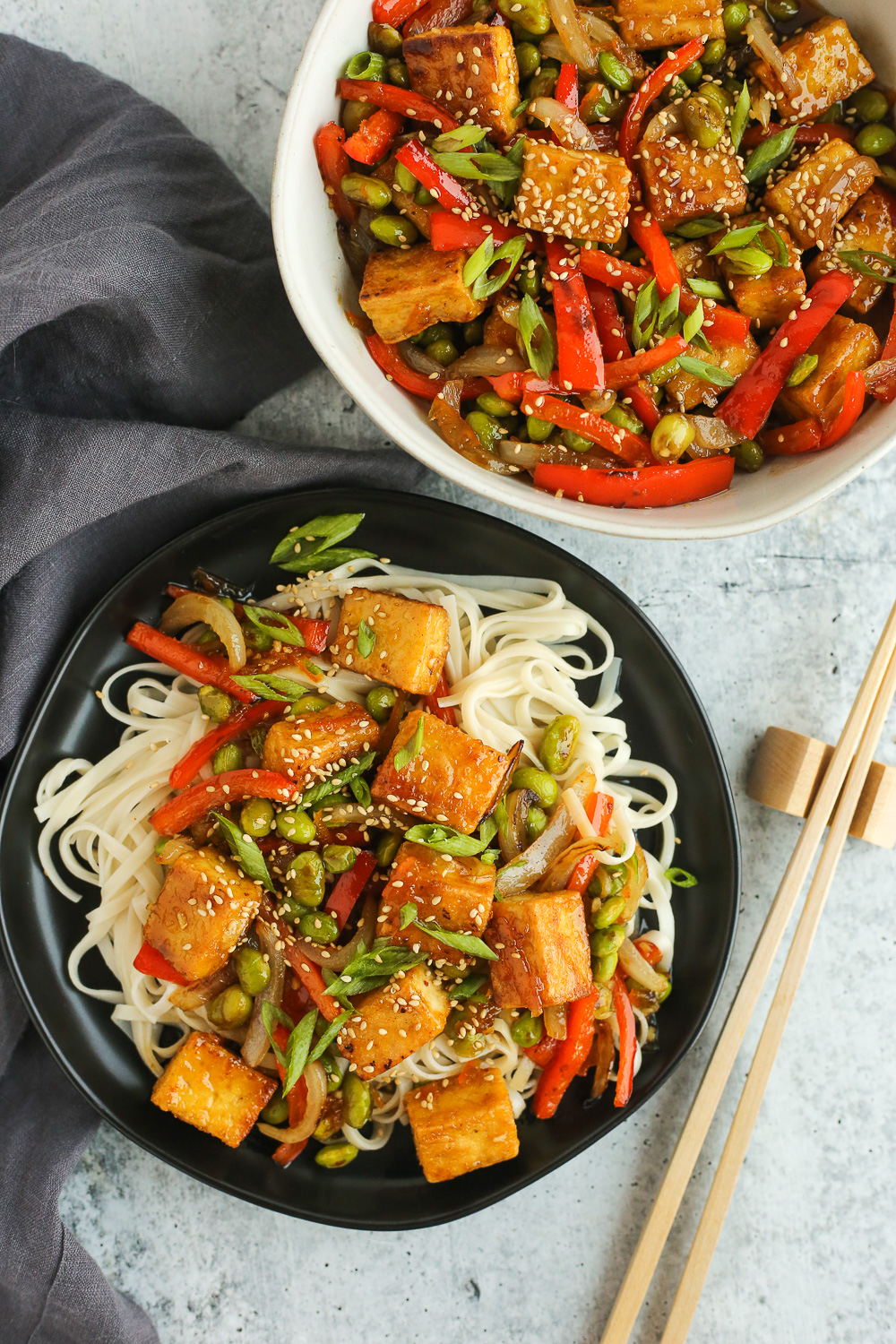
Why You’ll Love This Orange Tofu Recipe
- Who doesn’t love a good orange sauce? This version uses orange marmalade (which includes the orange juice + the orange peel) for a punch of sweet, slightly tart citrus flavor.
- Tofu is a versatile plant-based protein for many purposes. Once you master this technique for pan-frying, the sky’s the limit for other dishes!
- Using frozen edamame is a huge time saver. Thaw a bag in the fridge the night before, or run under cold water in a colander. You still have to do some other veggie prep, but at least this is one less thing to spend time on.
If you want to learn more about tofu nutrition, check out my post that shares some Myths and Facts About Soy Foods. Worried about soy and cancer? Don’t be! Not only is it safe to eat every day, it’s a highly nutritious food with potential long-term health benefits.
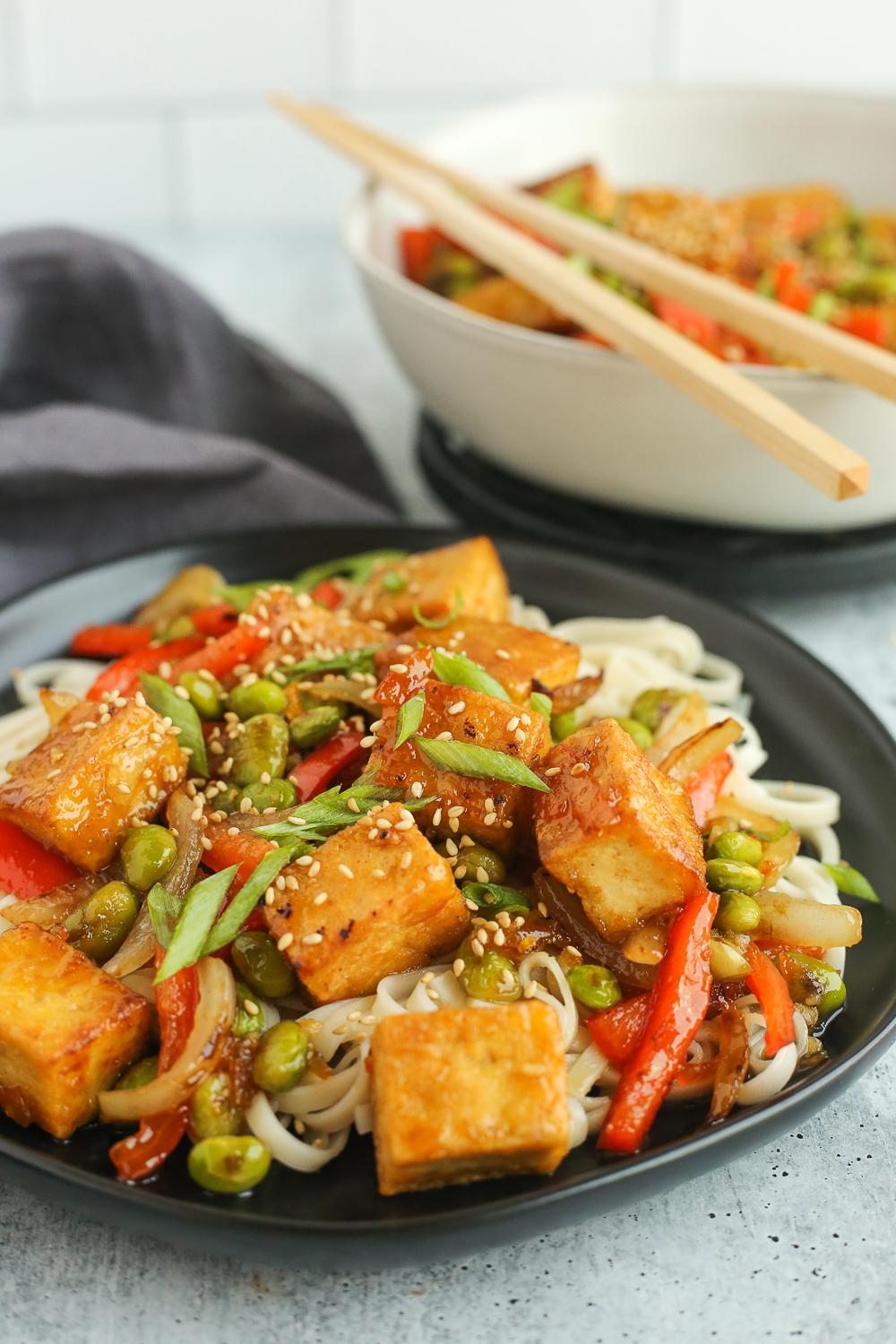
Orange Tofu Ingredients
Here’s what you’ll need to make this vegan stir fry with tofu and edamame:
- One block of extra firm tofu. You can use firm if that’s all that’s available, but I think the extra dense texture of this type of tofu is ideal for getting a nice crispy exterior
- Vegetable oil (100% soybean oil)
- Tempura batter or cornstarch. Tempura batter is usually wheat flour mixed with a little bit of cornstarch and a leavening agent such as baking soda (sodium bicarbonate). If you don’t have a pre-made batter on hand, simply use a dusting of cornstarch to get crispy, golden brown tofu cubes.
- Red bell pepper
- Yellow onion
- Shelled edamame, thawed if cooking from frozen
- Green onions
- Toasted sesame seeds, for garnish
- Rice or noodles, for serving. I used lo mein noodles in this version but you swap for your preferred type of noodle
Don’t have these specific veggies? Don’t worry! The good news with a stir fry is they’re incredibly versatile. Add whatever veggies you have. Try broccoli or cauliflower florets, mushrooms, or snow peas.
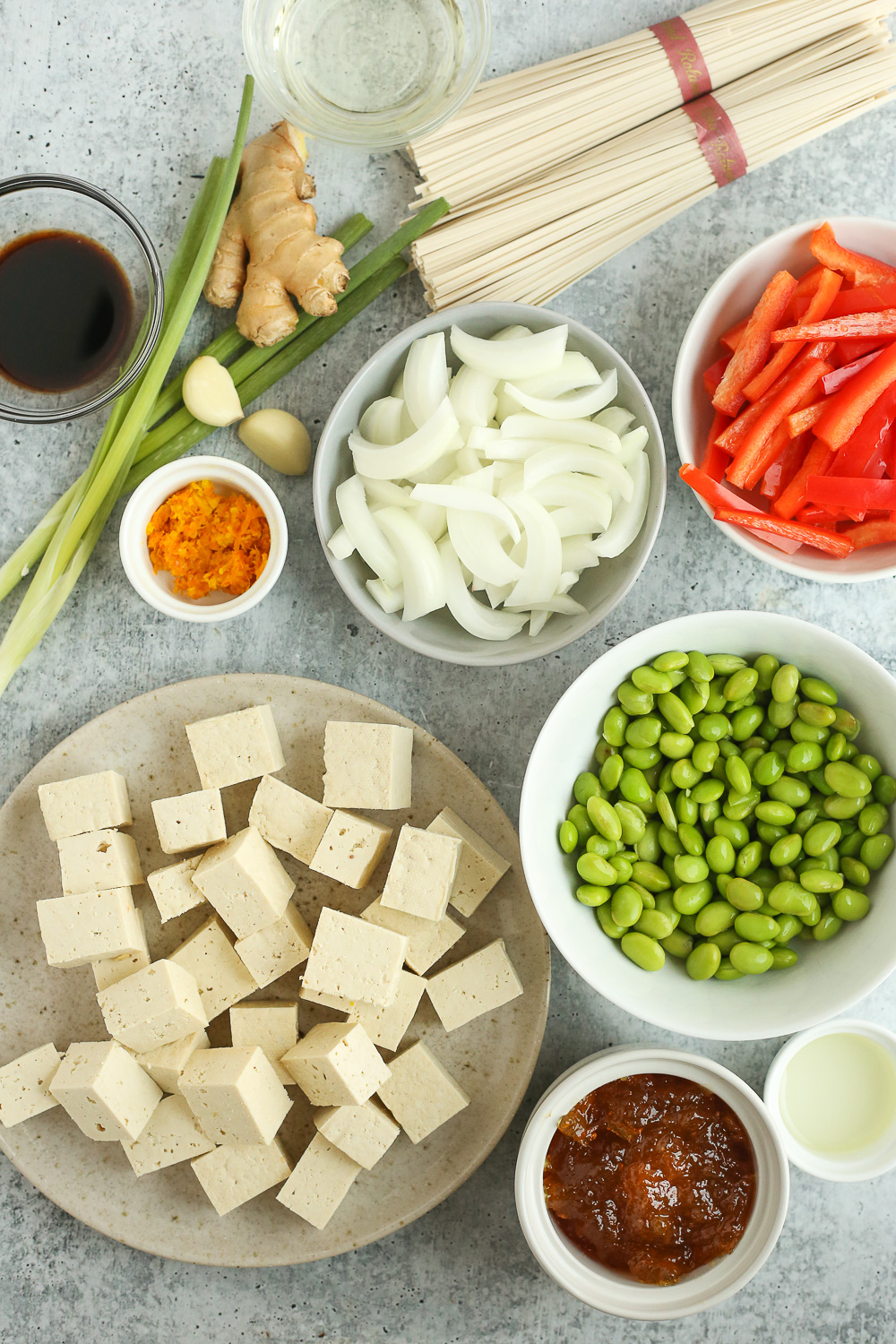
To make the homemade orange sauce, you need these simple ingredients:
- Orange marmalade. Marmalade uses the orange juice, pulp, and peel so you get an extra heavy punch of citrus flavor for this sauce. And no need to mess with making fresh orange juice!
- An orange for zesting
- Low-sodium soy sauce
- Rice vinegar
- Garlic
- Ginger
- All-Purpose MSG Seasoning or salt and pepper, to taste
For equipment, use a large nonstick skillet or wok if you have one. You’ll also need a saucepan or pot to prepare the lo mein noodles, or rice if that’s what you prefer to use.
And as with almost all of my recipes, you will need a standard cutting board + sharpened knife and measuring cups and spoons. Tongs or a heat-safe spatula are helpful, as is a microplane or zester and something heavy to press the tofu (more on that below).
A Note About Soybean Oil
Soybean oil is extracted from soybeans and has a neutral flavor. You can use it for roasting, frying, and even baking since it won’t impact the flavor of your finished recipe. It’s commonly marketed as “vegetable oil” so when you see this on the ingredient list for other recipes, start thinking of it as “100% soybean oil”.
Street Smart Nutrition Tip: As you’re shopping, keep in mind that although labels will say “vegetable oil” the majority of the time you’re really getting 100% soybean oil. To verify, check the ingredient list on the back label to see that “soybean oil” is the only ingredient.
Soybean oil contains mostly omega-6 polyunsaturated fatty acids, the type of fat that lowers blood cholesterol. In fact, in 2017, the United States FDA approved a health claim for soybean oil and heart disease based on its ability to lower cholesterol levels. Soybean oil also provides omega-3 fat and vitamin E.
Myths abound about the “inflammatory” nature of omega-6 fatty acids, but as a dietitian, I follow the available evidence. These concerns about inflammation have been rejected by the American Heart Association.
In fact, new research concludes that soybean oil lowers the risk of coronary heart disease without causing any undesirable effects, meaning it’s safe to use in recipes like this vegetarian stir fry. There is also a newer type of soybean oil (high oleic soybean oil) that contains more monounsaturated fatty acids compared to traditional soybean oil, but this oil is not widely available in grocery stores yet.
Soybean oil has a relatively high smoke point of 450 degrees F. An oil’s smoke point is the temperature at which the fats in the oil start to oxidize (break down). There is some concern that consuming oils heated past their smoke point could be harmful, so it’s generally a good idea to avoid using an oil with a lower smoke point for high-heat cooking methods like deep-frying, stir-frying, or roasting. This is exactly why I avoid something like sesame oil, even though I love the flavor. Instead, I do my cooking with soybean oil and save my toasted sesame oil for a light drizzle just before serving.
What’s the best way to press tofu?
I like to place my block of tofu on a paper towel on a plate or shallow bowl. Then I take a clean cutting board and stick that on top. I use my cast iron skillet (you can use any other heavy object) to squeeze out the excess moisture. It doesn’t take long – by the time I’ve chopped or sliced my other ingredients, my tofu is ready to go!
If you cook with tofu often, it may be worth investing in a tofu press.
I like to use extra-firm tofu because it has a dense enough texture to stand up to pan-frying without breaking apart. You can also find super-firm (a little less common) or firm and either option would work in this vegetarian stir fry recipe. You’ll notice I cut mine into rather large chunks, but that’s a personal preference. I like being able to bite into something hearty and satisfying, and it’s also easier to grab and flip with tongs while I’m cooking.
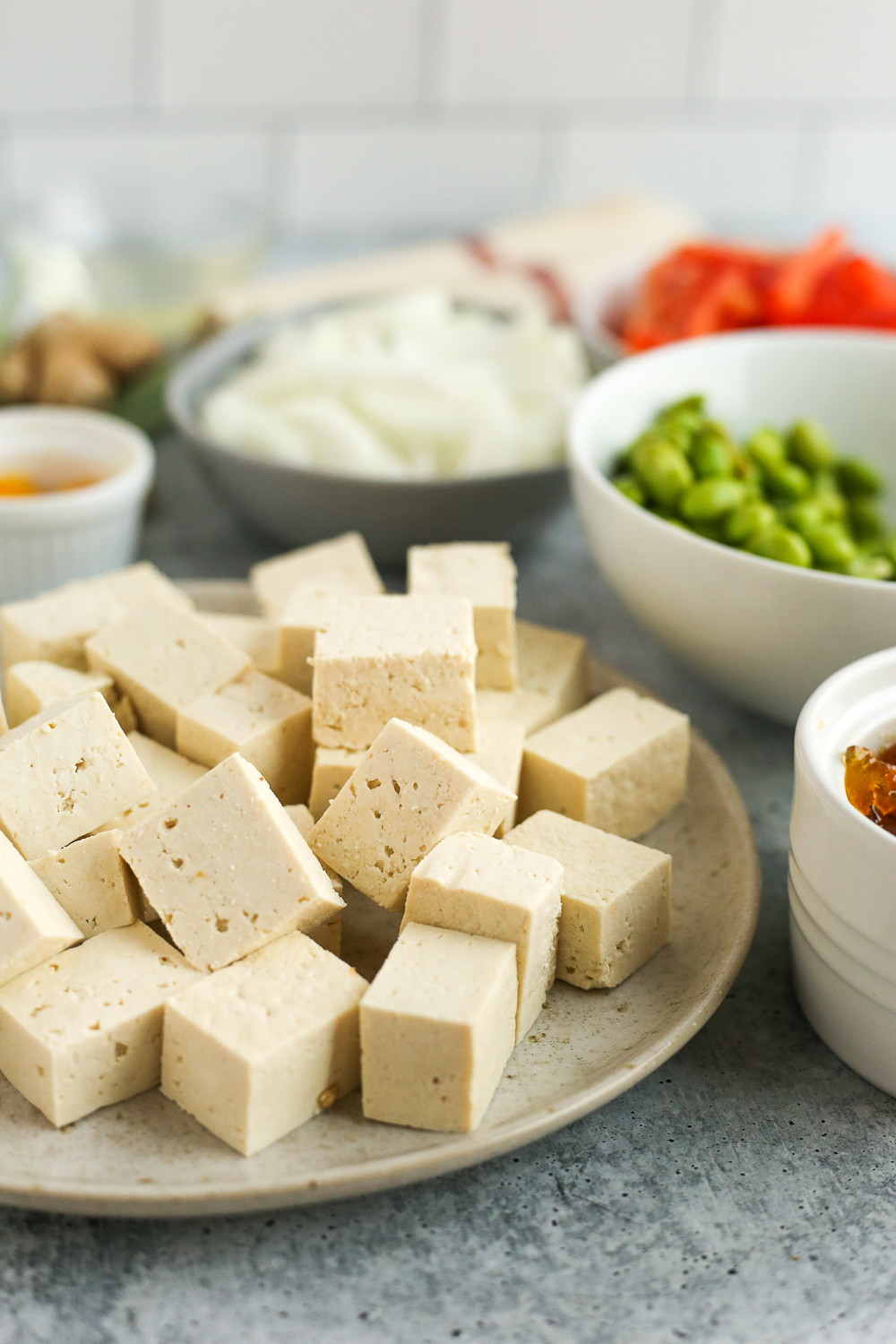
How to Make Crispy Orange Tofu
There are two key things to remember about making a good stir fry. First, use high heat. Second, don’t overcrowd your pan!
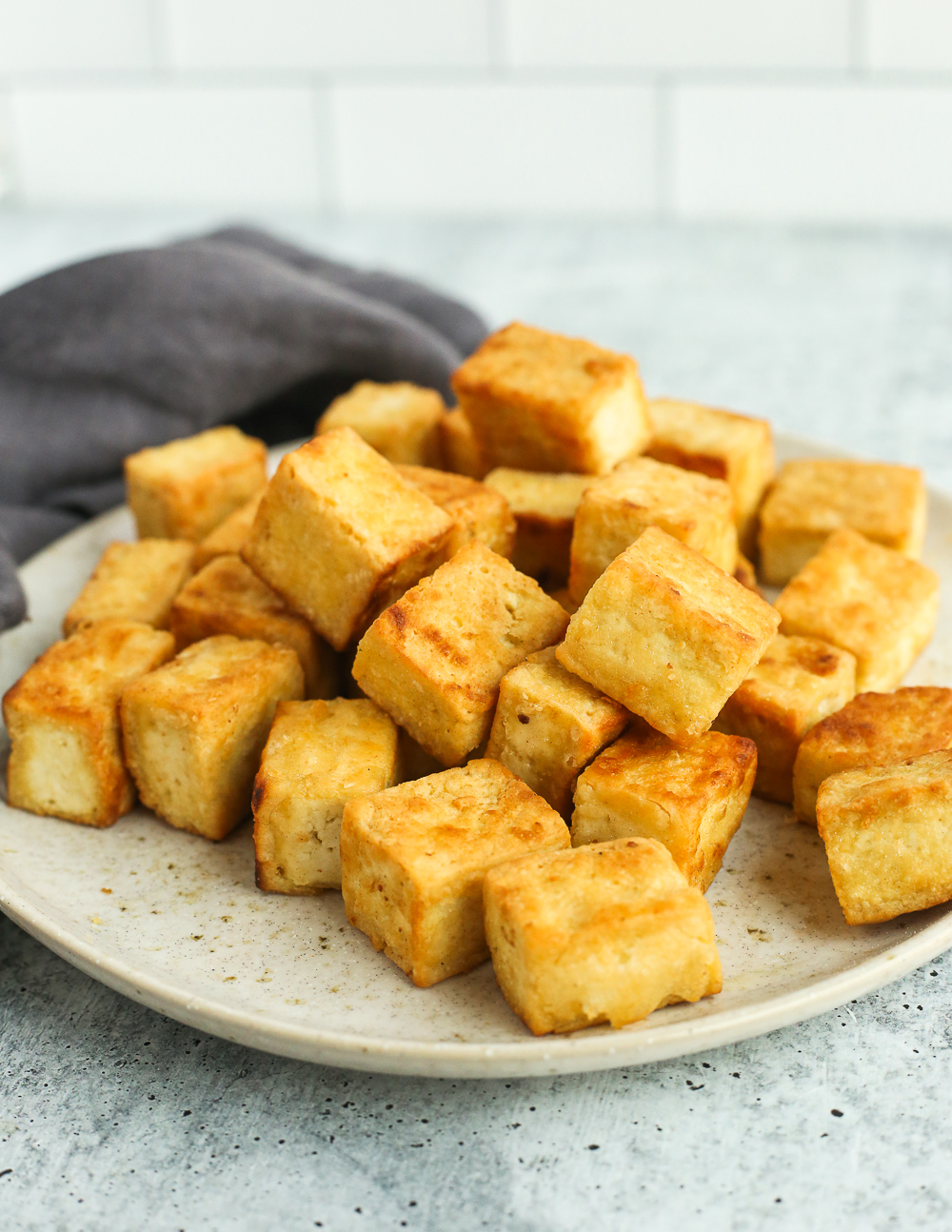
With that in mind, follow these steps to cook up this delicious homemade Crispy Orange Tofu recipe.
- Remove the block of tofu from the package and press to drain the liquid.
- In the meantime, prep the veggies by thawing the shelled edamame and slicing the red bell pepper and onion into thin slices. Measure out the garlic, ginger, and orange zest needed for the sauce.
- Add all the orange sauce ingredients to a small bowl. Whisk to combine. Set aside.
- Prep the tofu by cutting the block into large cubes. Place the cubes in a large Ziploc bag with the tempura batter or cornstarch and shake to coat. Remove the coated tofu from the bag and transfer it to a plate.
- To cook the tofu, heat a large skillet over medium-high heat. Once heated, add 1 1/2 tbsp of oil and heat until glistening. Add the coated cubes of tofu to the skillet in a single layer and pan-fry, without stirring, for 2-3 minutes. Work in batches if you need to so you avoid overcrowding the pan. Once a golden-brown crust begins to form, rotate the cubes and repeat the cooking process until the tofu is golden brown on all sides (about 10-12 minutes total). Transfer the crispy pieces of tofu to a bowl or plate to hold warm.
- Heat the remaining oil in the skillet, maintaining high heat, then add the sliced onions. Cook 1-2 minutes, stirring frequently, then add the sliced red bell peppers. Cook another 2-3 minutes, stirring frequently, then add the thawed edamame. Cook until the vegetables develop sear marks (about 2-3 minutes) then add the crispy tofu back to the pan.
- Add the prepared sauce and toss to combine until all ingredients are evenly glazed with the orange sauce. Remove from heat, garnish with sliced green onion and toasted sesame seeds (if using), and serve.
In the meantime, bring some water to a boil to cook the lo mein according to package directions. I prefer noodles to rice because it keeps the cooking process a little faster. The total cook time should take about 20-30 minutes.
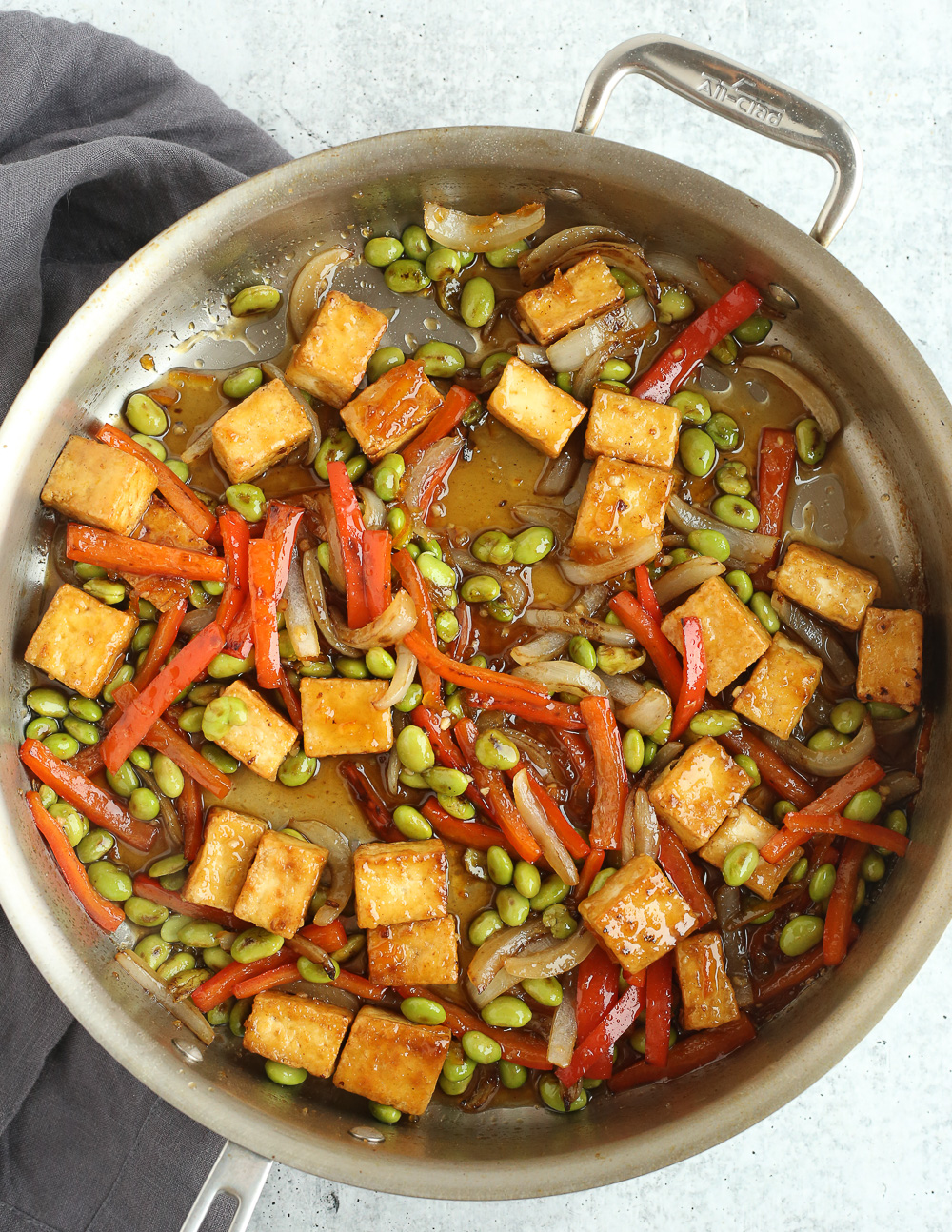
Serving and Storage Suggestions
To serve, I pile up some noodles and spoon everything else on top. As you eat, it will naturally mix to coat everything in the sweet and sour orange sauce.
Top with any extra garnishes you like. Depending on my mood, I like toasted sesame seeds, red pepper flakes, or sliced green onions. But I invite you to get creative and adjust the recipe based on what you like best.
Store leftovers in an airtight container and refrigerate. They should last 3-4 days and can easily be reheated in the microwave.
Just note that the tofu won’t stay crispy after being chilled and reheated. The coating absorbs moisture, both from the sauce and other ingredients plus the condensation as it cools. To avoid this, try cooking just the amount of tofu you plan to eat with the first round, then crisp up a new batch the next time.
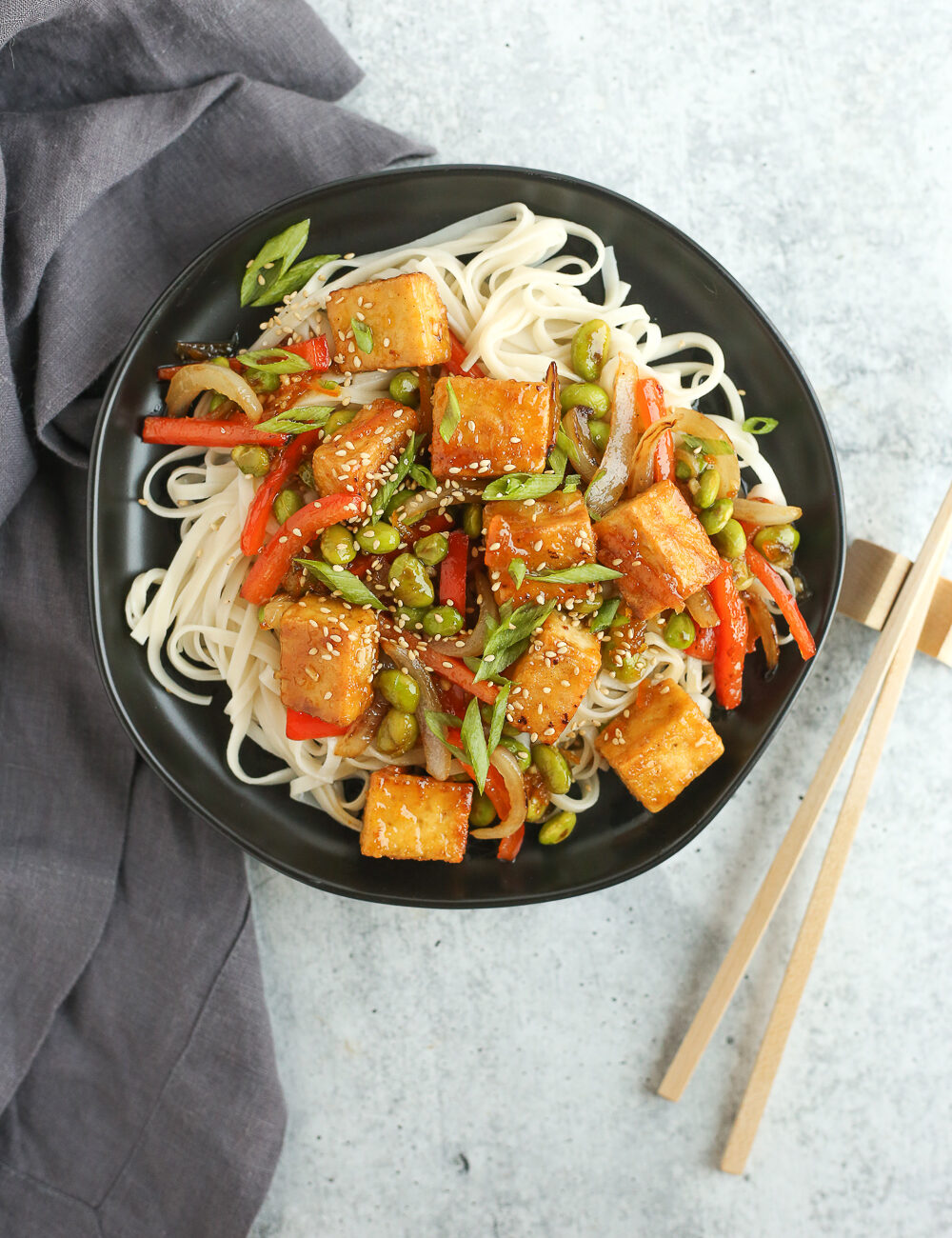
So with that, you know everything you need to know to make this Crispy Orange Tofu stir fry. Here’s the full recipe!
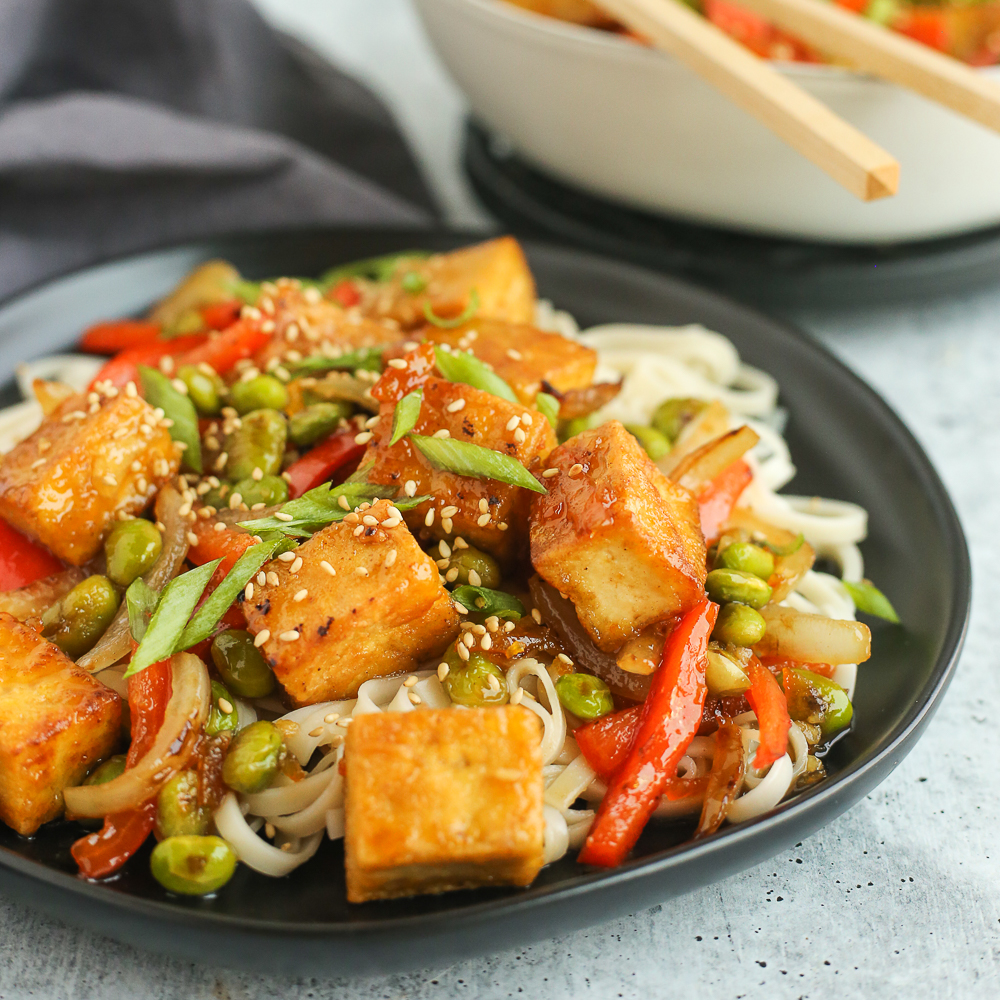
Crispy Orange Tofu Stir Fry with Edamame
Equipment
- large skillet or wok
- Saucepan
- prep bowls
- measuring cups and measuring spoons
- cutting board and sharpened knife
- tongs or heat-safe spatula
Ingredients
- 14 oz block of extra firm tofu
- 2 tbsp vegetable oil (100% soybean oil), divided
- 1/4 cup tempura batter or cornstarch
- 1 large red bell pepper, thinly sliced (about 1 1/2 cups)
- 1 medium yellow onion, thinly sliced (about 1 1/2 cups)
- 1 cup shelled edamame, thawed
- 2 medium green onions, sliced, for garnish
- 1/2 tbsp roasted sesame seeds, for garnish
For the Orange Sauce
- 3/4 cup orange marmalade
- 1/2 tbsp orange zest
- 2 tbsp low sodium soy sauce
- 1 tbsp rice vinegar
- 2 cloves garlic, minced
- 1 tbsp ginger, minced
- 1/2 tsp All-Purpose MSG Seasoning, or salt and pepper to taste
(Optional) Lo Mein Noodles
- 8 oz lo mein noodles, (Chinese egg noodles)
- water to fill a large saucepan
Instructions
- Remove the block of tofu from the package and drain the liquid. Set the block of tofu on a plate lined with a paper towel, then place a clean cutting board on top. Set a heavy item (such as a skillet or several books) on the cutting board to press the excess liquid out of the tofu.
- In the meantime, prep the veggies by thawing the shelled edamame and slicing the red bell pepper and onion into thin slices. Prepare the sauce by combining all ingredients and stirring to combine. Set aside.
- Prep the tofu by cutting the block into large cubes. Place the cubes in a large Ziploc bag with the tempura batter or cornstarch and shake to coat. Remove the coated tofu from the bag and transfer it to a plate.
- To cook the tofu, heat your skillet over medium-high heat. Once heated, add 1 1/2 tbsp oil and heat until glistening. Add the coated cubes of tofu to the skillet in a single layer and pan-fry, without stirring, for 2-3 minutes. Once a golden-brown crust begins to form, rotate the cubes and repeat the cooking process until the tofu is crispy on all sides (about 10-12 minutes total). Transfer to a bowl or plate to hold warm.
- Heat the remaining oil in the skillet, maintaining high heat, then add the sliced onions. Cook 1-2 minutes, stirring occasionally, then add the sliced red bell peppers. Cook another 2-3 minutes, stirring occasionally, then add the thawed edamame. Cook until the vegetables develop sear marks (about 2-3 minutes) then add the crispy tofu back to the pan.
- Add the prepared sauce and toss to combine until all ingredients are evenly glazed with the orange sauce. Remove from heat, garnish with sliced green onion and toasted sesame seeds (if using), and serve.
(Optional) Lo Mein Noodles
- Fill a saucepan with water and bring it to a boil over high heat. Once boiling, add the lo mein noodles and cook according to package directions, or about 3 minutes.
- Remove from heat, strain, and serve.
Notes
Nutrition
If you like this easy vegan orange tofu recipe, you might also like these recipes, too:
- Stir Fry Mushroom Noodles with Garlic and Ginger
- Massaged Kale Salad with Sesame-Lime Dressing
- Slow Cooker Sweet Potato and Butternut Squash Soup with Miso and Silken Tofu
If you try my crispy orange tofu stir fry, let me know what you think. Ratings and comments are always welcomed, I would love to hear from you!
And as always, thanks for visiting the Street Smart Nutrition blog. You can follow along for recipes, nutrition tips, and more on social media, YouTube, or my email newsletter. Cheers to more fearlessly nourishing meals!

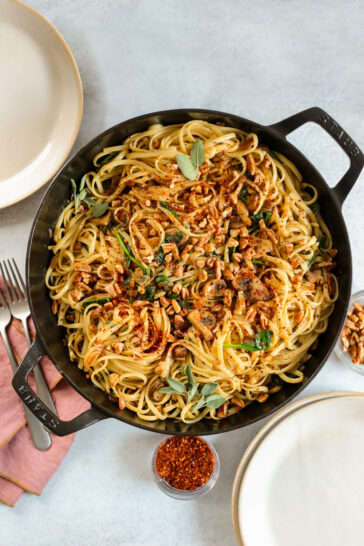
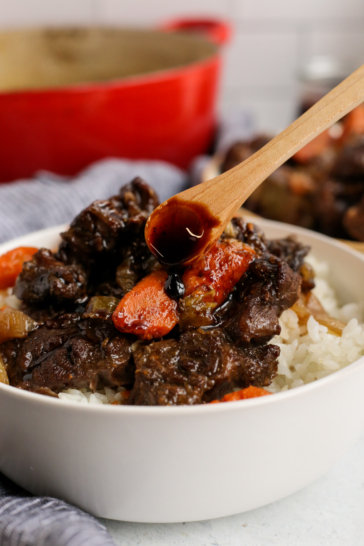
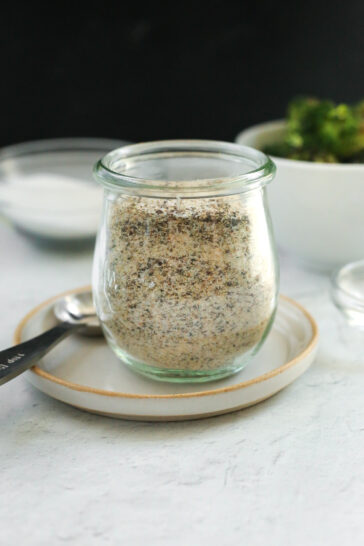
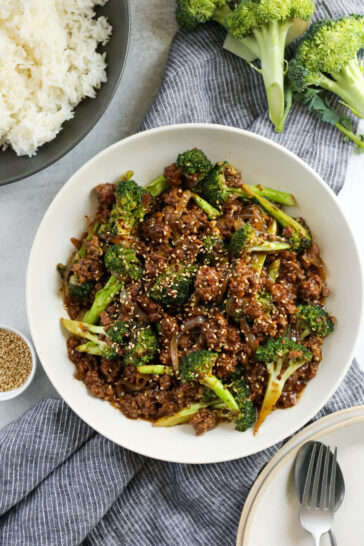

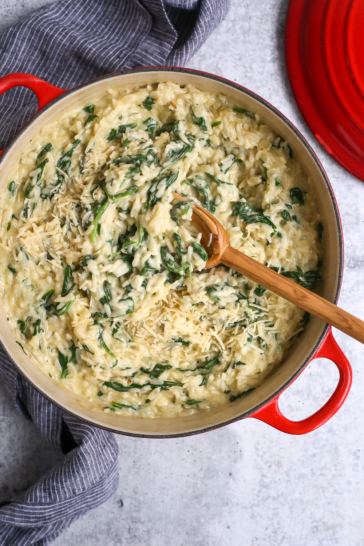







Questions & Reviews
The recipe says to add the crispy tofu back into the pan but never tells you how to cook the tofu.
You’re correct, and I apologize for that mistake in my editing process! That’s now been corrected, thank you for calling that to my attention. An updated version of the recipe card should appear if you refresh the page.
Msg?!?!
Yes, I cook with MSG. If you prefer to avoid it, you can also prepare this recipe with salt only. I recommend starting with 1/2 the called for amount because you can always add more during the cooking process or before serving.